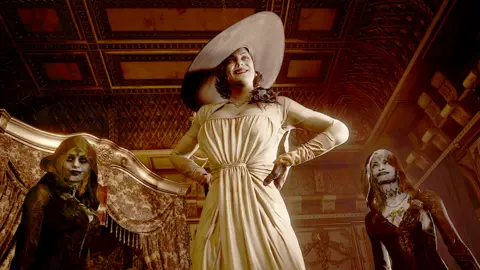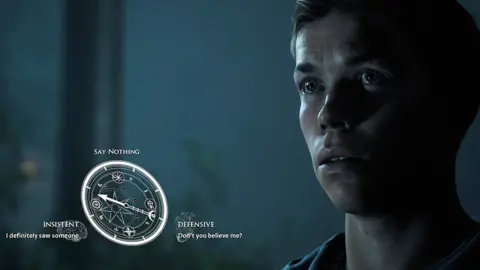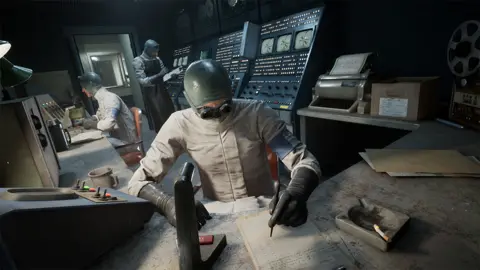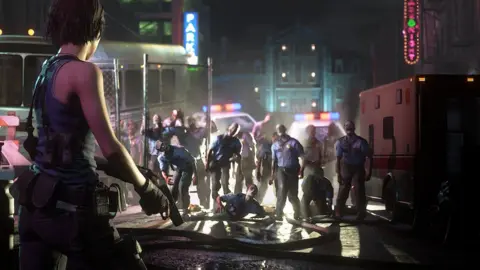Horror games: Is the genre in a golden age?
 Capcom
Capcom"Whaddaya buyin', stranger?"
If 2023's videogame sales charts are anything to go by, the answer is "horror games".
Resident Evil 4 Remake and Dead Space are among the top sellers this year, in a crowded field for quality titles.
And Sam Lake, writer of recent big release Alan Wake 2, told BBC Newsbeat the sequel had pivoted further into horror because he believes the genre is currently experiencing a "golden age".
While RE4 Remake and Dead Space are both updated versions of beloved scary classics, their popularity highlights the enduring appeal of horror games.
To get under the skin of the genre, Newsbeat spoke to some of the industry's best-known horror game makers to find out some secrets of the scare trade, and where it could go next.
How horror games create tension
According to Japanese developer Capcom, which brought horror mainstream with its Resident Evil series, video games offer one thing films and TV can't - interactivity.
They say the player being in control creates a "deeper level of immersion".
Philippe Morin is co-founder of Red Barrels, the small Canadian studio behind the Outlast series, which frequently appears near the top of "scariest games ever" lists.
He says horror games typically utilise "the notion of being powerless" to ramp up fear, limiting the players' abilities and giving them "no way to fight back".
Philippe says this restriction allowed the original Red Barrels team of just 10 people to be "smart" with its design, choosing a first-person view to make scares "more effective" but reduce the work needed on animating the main character.
 Supermassive Games
Supermassive GamesA developer that creates fear and tension in a different way is British company Supermassive Games, famous for its "playable horror movies".
Creative director Tom Heaton tells Newsbeat the experience, starring motion-captured actors, feels more like watching a film, but with a branching, choose-your-own-adventure narrative.
"When you're watching a horror movie, and one of the characters does something a bit stupid, people sometimes shout at the TV," Tom says.
"And our games are about giving you that choice. They're about saying: 'Okay, you decide what happens'."
Tom says the studio's titles, like 2016 sleeper hit Until Dawn and its Dark Pictures Anthology, are "great for a wider audience" perhaps less used to playing games.
Refining scares
The key to any good shock or jump-scare is surprise, and Capcom admits: "Once you have experienced a scary moment, it is difficult to judge its effectiveness objectively."
So how do you refine scares, when making games requires repeated playthroughs to check for bugs and other problems?
Easy. Find fresh victims.
Tom, from Supermassive, says testing the fright factor comes quite late in the process and they'll recruit people, observe them playing and "talk to them about what worked and what didn't work".
Once they've made adjustments, Tom says they "try to find someone else to try it for the first time rather than the same staff member replaying it".
Witness the horror
Developers have leant more into multiplayer horror since the dawn of the genre, especially as it's such a huge hit with streamers.
"Horror is a form that is really suitable for playing or watching with other people, and watching other people's reactions," says Tom.
Since its breakout hit Until Dawn, the company's baked multiplayer features into its games such as "couch co-op" where players share control, and online voting modes where an audience can choose the next move.
New modes can bring challenges, and Phillipe at Red Barrels says adding multiplayer to the team's latest, The Outlast Trials, has shown him there's "more chaos, more adrenaline, and it's more stressful", for players.
In single player, Philippe explains that jump-scares work a bit like a "Jack-in-the-box" planted at a certain point in a level to trigger when a player gets close.
For multiplayer, in levels designed for repeat plays, he says level designers will plant "hundreds of Jack-in-the-box items everywhere", and the game selects a random handful each time.
"And then when you play, there are some random factors that decide if, when you get close, the monkey will jump out of the box," he says.
 Red Barrels
Red BarrelsWhere can video game horror go next?
There's a lot of discussion at the moment about giving fans of popular franchises new ways to experience them.
Supermassive revealed earlier this year that it's working on a game based on Dead by Daylight, the popular horror multiplayer title.
Tom's tight-lipped when Newsbeat asks how that project is going, nor is he able to reveal whether a recent visit to Supermassive's Guildford HQ by Metal Gear Solid creator Hideo Kojima was more than a social call.
But he does say the company's "looking at all sorts of opportunities", and is always keeping an eye on developments in motion capture technology.
Capcom, which has just released a full-price version of Resident Evil Village on iPhones, has reinvented and rebooted its survival horror classic multiple times.
It says it's excited about "tremendously beneficial" developments in 3D sound - probably not a surprise to anyone who's been pursued through the halls of Raccoon City Police Department by Mr X.
And the developer says it hopes to bring a more "diverse player base" to the genre by providing more accessibility options to support the needs of those with disabilities.
But conversations about tech advances and horror games inevitably lead to one place: virtual reality (VR).
 Capcom
CapcomCapcom and Supermassive have both produced VR titles, and agree about the potential of the technology.
"It's a very immersive medium," says Tom. "It puts you right into the space and it can it sound and feel like you're in that space."
Philippe says Red Barrels gets asked about VR a lot, but doesn't feel it's something his team will move to soon as they concentrate on guiding Outlast Trials through its current early access phase.
"Maybe one day, we'll tackle it," he says. "But right now it feels like something that's really cool for some players, but most people still get motion sickness and so it's not something we feel makes sense to tackle."
And Capcom, despite its enthusiasm for the tech, admits it "will take some time" for VR to really take hold with gamers until the "variety of games... device wearability, comfort and the cost of entry" improves.
But if we are indeed in a "golden age of horror", the genre won't be going anywhere until that's happened.
It will still be lurking, lying in wait, until the time is right.


